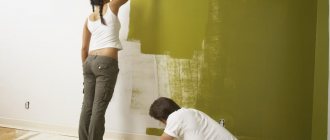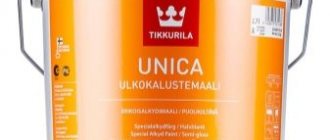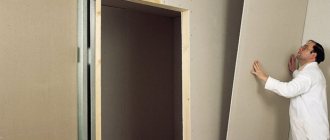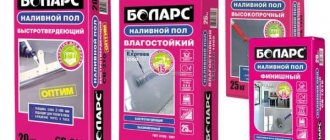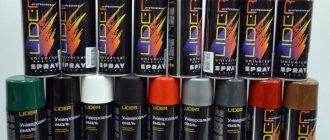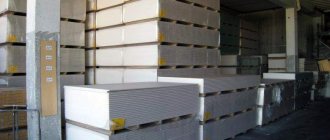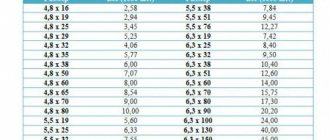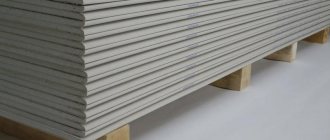13845 2 4
Kikimora June 15, 2017Speciality: I love my home, I like to equip it, periodically change something, do it with my own hands. There are no special hobbies. I am the administrator of a small women's forum.
Self-tapping screws for fastening drywall
When buying materials for repairs, you always try to accurately calculate the required quantity so as not to pay for too much. But while it’s easy to do this with large elements, it won’t be possible to immediately determine, for example, the number of screws per sheet of drywall. There are many nuances here.
However, this can be done if you know in advance the cladding fastening scheme and some general rules. Let's look at this issue.
Installation rules
When installing the sheet, certain conditions must be met:
- fastening is carried out in increments of 30-35 cm;
- when installing the ceiling, keep the spacing between fasteners 20-25 cm;
- in complex structures, for more reliable fixation, the step must be reduced to 10-15 cm;
- if the gypsum board is installed in several layers, then the number of screws per square meter. m of canvas and the distance between them must be calculated separately: for the bottom sheet a step of 40-60 cm is recommended, for the top sheet - at least 30 cm.
It is better to buy fasteners with some reserve, since during the work several pieces may turn out to be defective.
Briefly about the main thing
I don’t even think about how many screws are needed for 1 sheet of drywall, because I work with it all the time and always have a supply of fasteners. But when performing a one-time job, this issue may become relevant: you need to report to the customer for expenses. When making for yourself, it’s better to take more - they don’t ask for extra screws, but they can come in handy at any time. If you really need to calculate, draw a diagram of the frame, select the fastening step, and then multiply and add. This is for complex structures. For simple ones, take 40 for the walls, 60-70 for the ceiling, you can’t go wrong.
Question
Write in the comments if you have run out of drywall-wood screws, will you use metal fasteners for a wooden frame or go to the store?
GKL installation technique
- All fasteners are screwed exactly vertically to prevent cracking or destruction of the building material.
- The self-tapping screw is deepened into the profile by no less than 1/3 of its length.
- The screw head is recessed by 1-1.5 mm.
- The self-tapping screw that entered the material at an angle is removed, and a new one is screwed in, retreating 5 cm from the defective hole.
- It is unacceptable for any debris or objects to remain between the canvas and the frame.
- In order not to harm the canvas, leave a section of at least 1 cm from its edge.
Characteristics of self-tapping screws for installing profiles under drywall
To connect the metal parts of the frame, parts of the following formats are used:
- Length – 9.5 mm, diameter – 3.5 mm;
- Length 11 mm, diameter 3.9 mm.
Due to their miniature size, they are called “bug”. A distinctive feature of the cap is a cross-shaped notch for the bit attachment and marks on the inside that protect it from arbitrary self-twisting. A “bug” with a self-sharpening tip is used for profiles with a thickness of 1.5-2 cm, with a sharp end - for strips with parameters of 0.9-1.2 cm. Marked as LN.
The distance between the fasteners is arbitrary, but since they are used for fixing the rack profile to the starting one, attaching hangers and jumpers to the frame elements, the step is repeated approximately every 50 cm (depending on the sheathing pattern).
Types of self-tapping screws
For metal profiles, metal hardware is used. When installing gypsum boards, fasteners with a length of 25 mm are used in one layer, and 35 mm in two layers. All of them have a protective coating (phosphate or zinc), a sharp end and a frequent thread. If the thickness of the profile is 7 mm or more, take a fastening element (“bug”), the head of which has notches that do not allow it to unscrew on its own. Self-tapping screws for wood profiles do not have such frequent threads. To install gypsum boards, screws 32 mm long are used in one layer, and 45 mm long in two layers. No screws can be interchangeable. For design reliability, each of them must be used strictly for its intended purpose.
Features of using a screwdriver:
- The attachment points are marked.
- screwing in the screw begins at the maximum possible speed and then it is reduced by half;
- at the very end of tightening the screw, if you do not calculate your strength, the canvas may crumble;
- To maintain vertical screwing and prevent deformation of the head, use a magnetic attachment and a bit designed specifically for self-tapping screws.
Installation with a screwdriver: features and tricks
Before starting work, you need to mark the fastening points so that the distance between the fastening points is the same. It is much faster to secure a sheet with a screwdriver than with a conventional screwdriver. However, working with this tool has some features:
Using a screwdriver instead of a regular screwdriver will greatly reduce your work time
- at the very beginning, the screw is screwed in at maximum speed, then it is reduced by half;
- At the last stage of twisting, you can miscalculate the force and crumble the panel.
- the use of a special magnetic attachment and a bit for self-tapping screws allows you to maintain a vertical axis during operation and prevents deformation of the head.
How many self-tapping screws are used on average for gypsum boards?
The number of screws depends on the pitch of their attachment to the profile and the number of sheathing guides. We must not forget about future loads on the material and its thickness. Putty with subsequent painting is one load-bearing solution, another case is tiles on gypsum board. Depending on the parameters of the tile, the step between hardware is reduced to 15-10 cm. In addition to standard panels (1200 × 2500 mm), there are also non-standard ones. To make the calculation, you need to know the pitch for the screws and the distance between the profiles when creating the frame of a wall or ceiling. It is recommended to leave a distance of 30 mm between the screws; profiles are usually placed at a distance of 400 mm from each other. The last value depends on the upcoming load. We should not forget that when installing a suspended ceiling, the frame will be strengthened in some areas, but not in others. So the final result is calculated for a single case. Practice shows that one standard gypsum board requires approximately 70 hardware for single-layer fastening and 110 for double-layer fastening. If it is necessary to increase strength, the step between the screws can be reduced to 10 cm, but not less, in order to avoid damage to the material.
What is the difference between a self-tapping screw and a screw?
There is often confusion when determining the difference between fasteners. Although both options perform the same function, there are significant differences between them:
- Screw. This is a product that is used to fasten parts together. It has a head and a rod on which there is an external thread. It is due to this that an internal thread is formed in the selected fragment, which holds the parts.
- Self-tapping screw. This is where the most questions arise. The word is short for "self-tapping", which refers to a screw with an external thread and a head. Due to the structural features, it is much easier to screw in such an element.
Although GOST 27017-86 “Fastening products. Terms and Definitions" includes many concepts, among which both names are found; for accuracy, they are included in separate regulatory documents. Therefore, it is advisable to rely on GOST number 1147-80, which gives an idea of screws, and GOST 11652-80, which describes the characteristics of self-tapping screws.
The main differences between products for fixation:
- Self-tapping screws can be screwed into various types of surfaces without special preparation due to sharper and steeper threads.
- Working with a screw requires a lot of effort, so in some cases, especially when it is necessary to screw the product into a dense base, preliminary preparation is needed. The technology involves the formation of a smaller hole.
- For greater convenience, the self-tapping screw is equipped with a special tip: it can be sharp, which ensures easy penetration, or in the form of a drill, cutting a passage in a solid structure.
- Screws have threads that occupy the entire shank or part. An empty area is needed to center the fastener.
In modern domestic practice, the differences between self-tapping screws and self-tapping screws have been erased, and even experienced drywallers cannot clearly formulate the difference between these screws
. At the moment, there is a wide range of self-tapping screws that are not included in any domestic regulations, so in everyday speech a self-tapping screw and a screw are often identical concepts.
Mounts for main body
When installing or repairing anything, choosing the right fastener is important. Since there is a wide variety of jobs that require fixing objects made of different materials, products for fastening are offered in a wide range according to needs. Drywall is used to mount ceilings and create partitions. Fasteners are required to install the sheets. Self-tapping screws are best suited for this purpose; you will have to stock up on them in considerable quantities. Saving here is not recommended if you want the structure to last for many years. Their exact consumption cannot be determined. The bases, which can support plasterboard sheets, are available in two versions: wooden and metal. There are different types of fasteners for them: dowel-nail, dowel-butterfly, self-tapping screws for wood and metal. Without the latter, restoration activities are difficult to imagine. They are used strictly in accordance with the material from which the frame for the ceiling or partition is made. Don't forget that wood screws and metal screws are not interchangeable!
Types of drywall: how to easily screw in self-tapping screws
For interior decoration, standard plasterboard (gypsum plasterboard) is used. It is used on walls, ceilings and installation of partitions in rooms with humidity levels up to 70%. This material is gray, sometimes blue. Choosing high-quality drywall will reduce costs.
Moisture-resistant (gypsum plasterboard) has a moisture absorption of less than 10% and contains fungicidal additives. This is suitable for rooms with high humidity. Leaf color is green.
Fire-resistant (GKLV) contains a reinforcing additive. Designed for premises with strict fire safety requirements. Color – red.
Moisture-resistant drywall with increased resistance to open flame (GKLVO) combines the above properties. Few manufacturers produce it. For example, KNAUF.
Plasterboard with a thickness of 9.5 mm is suitable for ceilings, and 12.5 mm for walls. They also differ in the type of edge. For home repairs, sheets with longitudinal rectangular PC (VR, KR) and longitudinal beveled UK (AK) edges are often used.
Consumption of self-tapping screws
The calculation of the number of screws required must be correct. If not enough is used, the drywall will not adhere well. If they are screwed in in excess, the material will crack. Professionals, based on their experience, advise placing the screws relative to each other in increments of 35 cm. If it is necessary to strengthen the system more, the distance between the screws can be reduced. The distance from the edge of the profile should not be less than 10 mm, otherwise it is highly likely to collapse. The sections when fixing the profile are at least 10 cm. The consumption of hardware depends on how much it is necessary to strengthen the ceiling structure or partitions.
A step of 35 cm refers to covering the HA sheets in one layer. If the ceiling is stepped or the panels are fastened in two layers, the standards will change. On the first panel, the self-tapping screws are screwed in increments of 60 cm, on the second - 35 cm, which is sufficient to assemble the structure with good quality. Number of screws per sq. m of sheet fluctuates in the range of 20-25 units. It's always better to take extra. If you need accurate data, visit the online service and use electronic calculation. The calculator program itself will calculate the consumption of parts for fasteners, as well as other materials necessary for work. However, calculating the number of hardware using the program does not provide a complete guarantee that some of the fasteners will not be defective or damaged during operation. Therefore, buy them with a 15% reserve.
Tips on how to use self-tapping screws correctly:
- screw the fasteners at an angle of 90°, this will ensure the strength of the structure;
- if the screw enters the material obliquely, it must be removed and screwed in again, stepping back 5 cm from the previous hole;
- monitor the depth of entry of the self-tapping screw into the frame, it should be at least 1/3 of its length;
- after screwing in the hardware, check the surface for smoothness; its head must be recessed strictly by 1 mm, otherwise, with a large deviation, there is a possibility of a threat to the entire structure;
- when installing a stepped ceiling and two-layer partitions, the panels should be overlapped;
- there should be no foreign materials or debris between the base and the gypsum board, since drywall has a tendency to deform;
If you follow the advice, the consumption of fasteners will be optimal. It can increase solely due to damage to structural elements.
Drywall sheet size
GKL are produced in standard sizes - 2500 x 1200 mm. In addition, there are also non-standard panels measuring 2000 x 600 mm. In order to calculate the approximate number of screws, it is necessary to take into account the first option, since it is more common.
- Mounting step. Most experts recommend making the distance between the screws when attaching drywall to a vertical surface in increments of 35 cm. It is this indicator that can ensure the reliability and durability of the finished structure.
- The distance between the screws when attaching drywall to the ceiling is 10–20 cm.
- Number of gypsum board layers. When deciding to install several layers of drywall at once, screws should be fastened at different intervals. For example, the first layer will be attached after 60 cm, the second layer - after 35 cm.
So, having decided on the main indicators, you can accurately calculate the consumption of self-tapping screws per 1 m2 of drywall. One sheet of this material will take approximately 70 pieces, two layers - at least 110. By choosing the required number of panels for the future structure and a certain fastening step, you can easily calculate the consumption of hardware.
